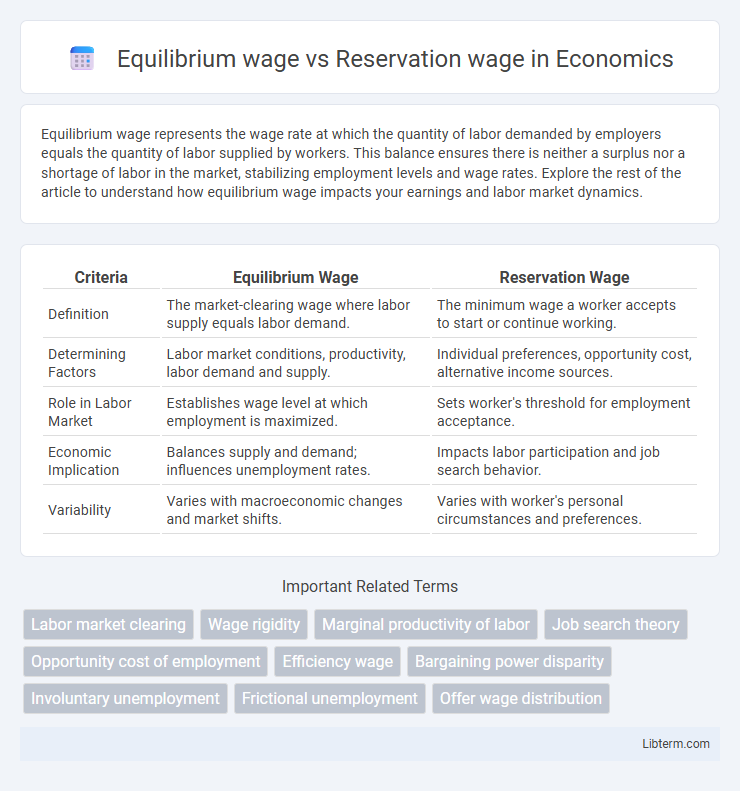Equilibrium wage represents the wage rate at which the quantity of labor demanded by employers equals the quantity of labor supplied by workers. This balance ensures there is neither a surplus nor a shortage of labor in the market, stabilizing employment levels and wage rates. Explore the rest of the article to understand how equilibrium wage impacts your earnings and labor market dynamics.
Table of Comparison
| Criteria | Equilibrium Wage | Reservation Wage |
|---|---|---|
| Definition | The market-clearing wage where labor supply equals labor demand. | The minimum wage a worker accepts to start or continue working. |
| Determining Factors | Labor market conditions, productivity, labor demand and supply. | Individual preferences, opportunity cost, alternative income sources. |
| Role in Labor Market | Establishes wage level at which employment is maximized. | Sets worker's threshold for employment acceptance. |
| Economic Implication | Balances supply and demand; influences unemployment rates. | Impacts labor participation and job search behavior. |
| Variability | Varies with macroeconomic changes and market shifts. | Varies with worker's personal circumstances and preferences. |
Understanding Equilibrium Wage
Equilibrium wage represents the rate at which the quantity of labor supplied equals the quantity demanded, balancing employer needs and worker availability in the labor market. This wage level is crucial for understanding employment stability and labor market efficiency, as it minimizes unemployment due to wage mismatches. Unlike the reservation wage, which is the minimum wage a worker accepts to enter the labor force, the equilibrium wage reflects actual market conditions shaped by aggregate supply and demand.
Defining Reservation Wage
Reservation wage is the minimum wage rate at which a worker is willing to accept a particular job, reflecting the lowest acceptable compensation to justify employment over unemployment or leisure. It depends on factors such as individual preferences, alternative income sources, and the opportunity cost of time. Equilibrium wage, meanwhile, is the wage rate determined by the intersection of labor supply and demand in the market, often exceeding the reservation wage to attract workers.
Key Differences: Equilibrium vs Reservation Wage
The equilibrium wage is determined by the intersection of labor supply and demand in the job market, representing the actual wage rate at which workers are hired and employers find labor. The reservation wage is the minimum wage level at which a worker is willing to accept a particular job, reflecting individual preferences, opportunity costs, and alternative employment options. Key differences lie in that the equilibrium wage is a market-driven rate reflecting aggregate conditions, while the reservation wage is subjective and varies across workers based on personal thresholds for employment acceptance.
Factors Influencing Equilibrium Wage
Factors influencing equilibrium wage include labor market supply and demand dynamics, productivity levels, and worker skills. Changes in reservation wage, influenced by individual preferences, unemployment benefits, and alternative job opportunities, also affect the labor supply curve. Government policies such as minimum wage laws and labor union activities further shape the equilibrium wage by altering wage-setting mechanisms and negotiation power.
Determinants of Reservation Wage
The reservation wage is primarily determined by factors such as an individual's alternative income sources, including unemployment benefits and savings, personal preferences for leisure versus work, and prevailing labor market conditions like job availability and wage rates. Unlike the equilibrium wage, which is set by supply and demand in the labor market, the reservation wage reflects the minimum compensation a worker requires to accept a specific job offer. Economic stability, individual risk tolerance, and non-monetary job attributes also significantly influence the reservation wage level.
Role of Labor Market in Wage Formation
The labor market plays a crucial role in wage formation by balancing the equilibrium wage, where labor supply equals labor demand, and the reservation wage, which is the minimum wage a worker is willing to accept. Employers set wages considering the equilibrium wage to attract sufficient employees while workers compare offers against their reservation wage to decide on employment acceptance. This interaction determines employment levels and wage rates, influencing labor market efficiency and overall economic productivity.
Impact of Economic Policies on Wages
Economic policies such as minimum wage laws and tax incentives directly influence equilibrium wages by altering labor market supply and demand dynamics. Reservation wages, the minimum wage at which workers are willing to accept a job, can shift upward due to enhanced social welfare programs or unemployment benefits, affecting labor participation rates. Changes in fiscal and monetary policies impact both wages by modifying employers' labor costs and workers' reservation thresholds, reshaping overall employment levels.
Implications for Employers and Employees
Equilibrium wage represents the market-clearing salary where labor supply equals demand, influencing employers to set competitive pay rates to attract talent without incurring excess labor costs. Reservation wage is the minimum compensation an employee is willing to accept, guiding workers' job acceptance decisions and affecting labor supply elasticity. Employers must balance offering wages above reservation levels to ensure employee retention while aligning with equilibrium wages to maintain operational efficiency and cost-effectiveness.
Wage Negotiation Strategies
Equilibrium wage represents the market-clearing rate where labor supply equals demand, serving as a benchmark in wage negotiation strategies to ensure competitive offers. Reservation wage is the minimum acceptable salary a worker is willing to accept, guiding negotiators to avoid undervaluing labor and maintaining motivation. Effective wage negotiation balances these concepts, leveraging market data and individual thresholds to achieve mutually beneficial agreements.
Future Trends in Wage Dynamics
Future trends in wage dynamics reveal growing divergence between equilibrium wages, set by labor market supply and demand, and reservation wages, influenced by individual worker preferences and alternative income sources such as gig economy jobs and universal basic income experiments. Technological advancements and remote work flexibility are shifting reservation wages upward as workers value non-monetary benefits more, potentially causing upward pressure on equilibrium wages in competitive sectors. Data from recent labor market studies indicate increased bargaining power for specialized skill sets, which may further widen the gap between reservation wages and market-clearing equilibrium wages in the coming decade.
Equilibrium wage Infographic

 libterm.com
libterm.com